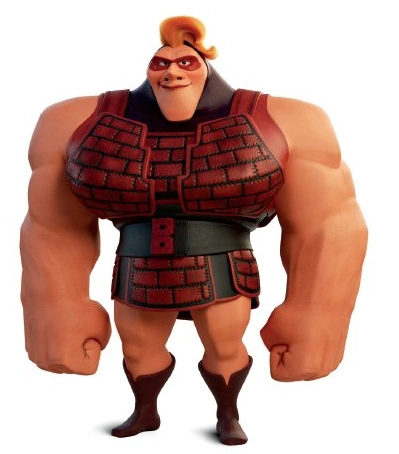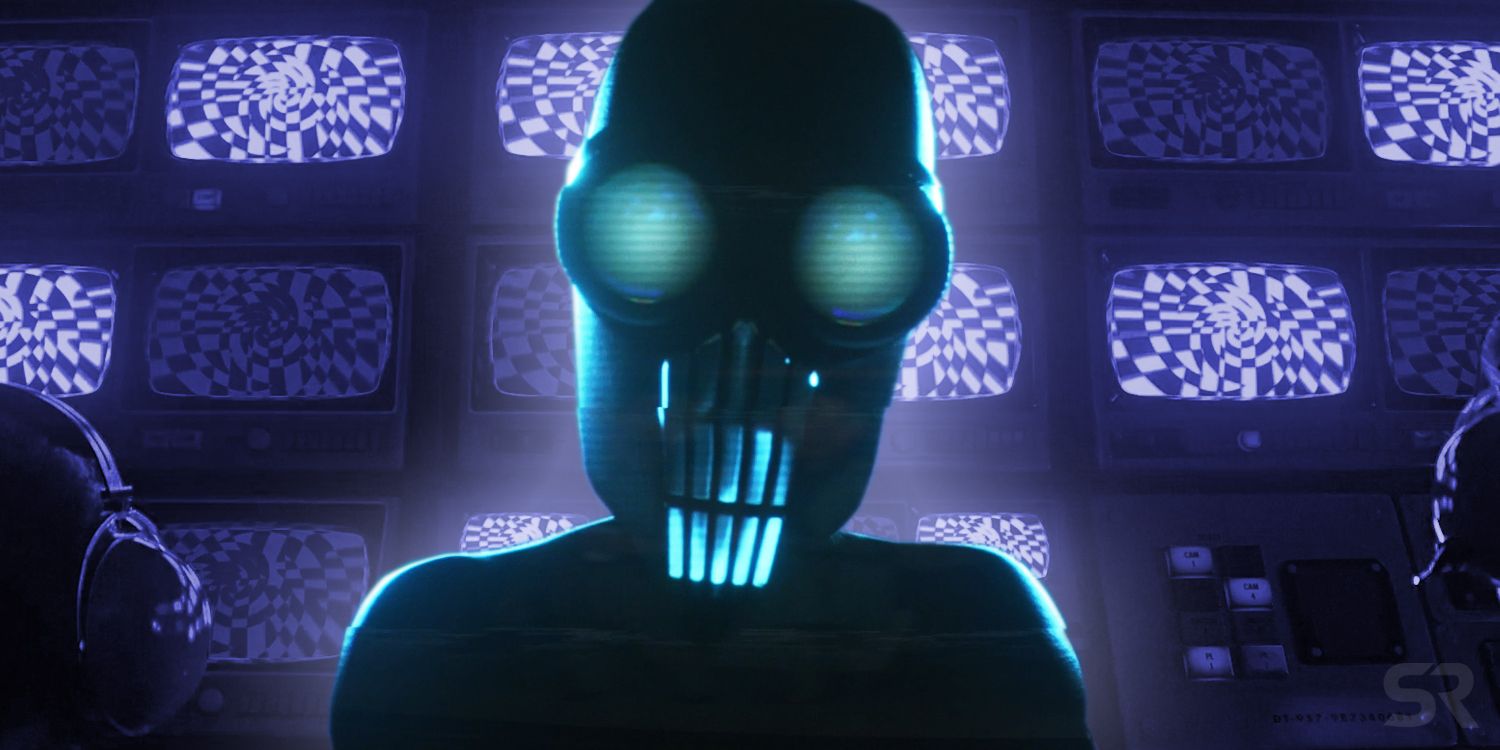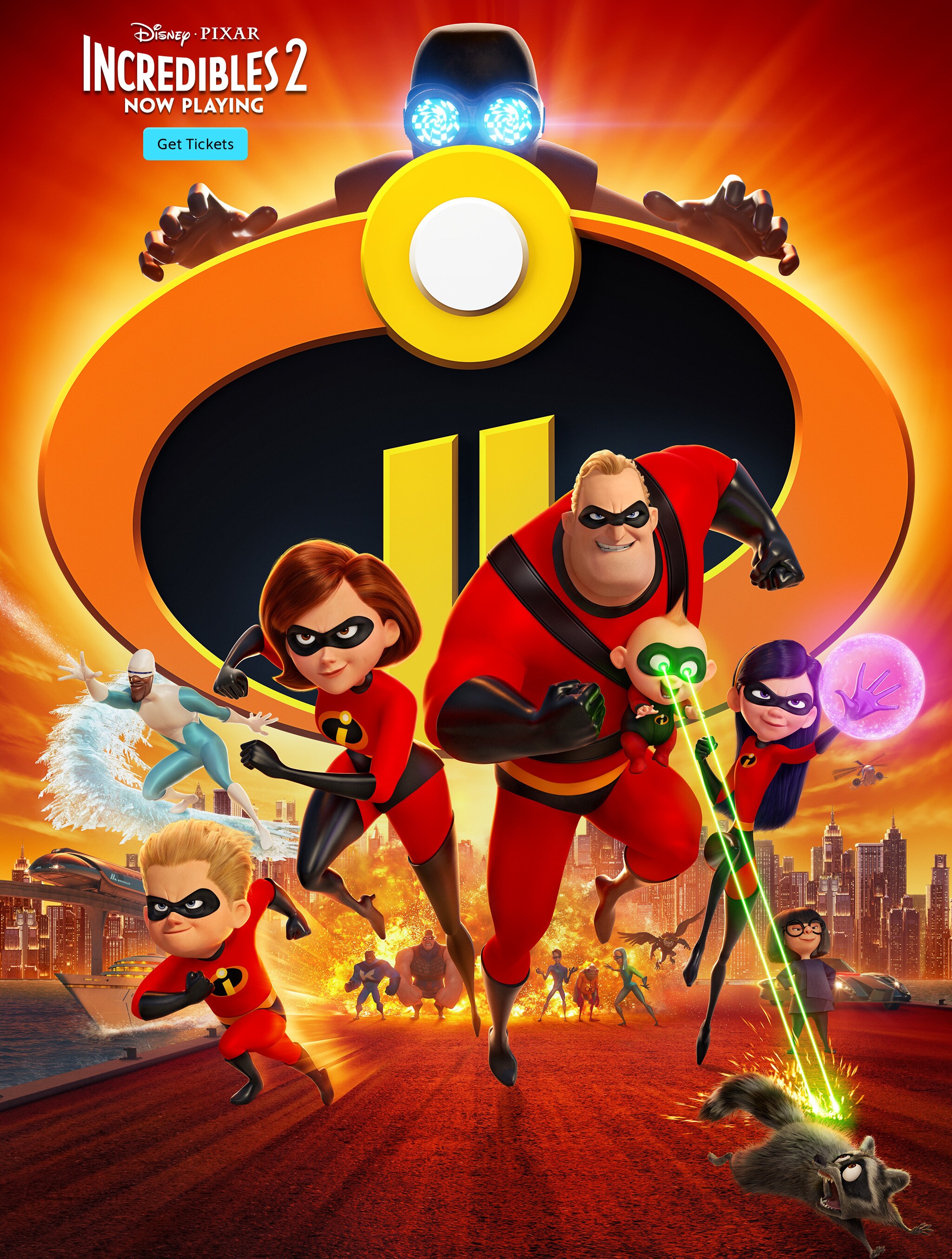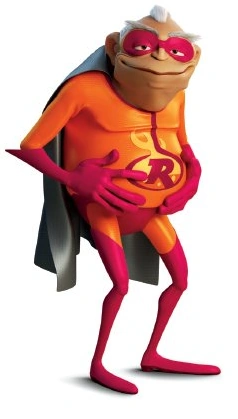Pixar has an uneven track record when it comes to sequels. Sure, you've got gems like
Toy Story 2 and
3, movies that are arguably better than the original in a lot of ways, while still expanding on the same formula. But you've also got
Monsters University, a pretty fun movie that really didn't need to exist, and
Finding Dory, a...less fun movie that needed to exist even less. And let's not even discuss
Cars 2, a spy/action movie with race cars that somehow managed to have exactly one entertaining scene. Add to this the fact that Pixar's quality of late has been equally uneven (full disclosure: I heard
Coco was good, but have yet to see it...it's on my Netflix list, okay?). For every
Inside Out, it seems like we get at least one
Good Dinosaur.
So where does
Incredibles 2 fall on that spectrum?
Kind of...in the middle, actually. It's way better as a movie than
Finding Dory, and it's a million times more fun than
Cars 2 could ever hope to be, but it doesn't quite manage to replicate what the
Toy Story sequels pulled off.
To really give a good idea of what's going on here, I'm going to break this review down into some sections.
The Good
Same Formula, New Story
A good sequel either expands on the original (effectively doing more of the same, but enhancing each aspect) or continues the story (think The Two Towers). This movie effectively does both. You can tell that, in many ways, it's a beat-for-beat retread of the first one, but it tackles just about everything from a different angle.
For example, Elastigirl's story is basically what Mr. Incredible's was from the first movie (minus the fat jokes, obviously), starting with a wealthy benefactor (composed of a male-female partnership) that pays for just about all their needs while giving them a chance to cut loose and be heroes even though society doesn't understand them. There's a couple switchups in there, namely the volcano being swapped out for a skyscraper, but the premise remains just about the same. Meanwhile Mr. Incredible is dealing with the kids at home. The just power through it brand of problem solving that Bob had in the first movie is applied to entirely different situations in this one. Instead of figuring out how to take out a killer robot, or working out how to hide his hero work from his wife, he's trying to wrap his head around Dash's math homework and Violet's relationship problems. Just like in the first movie, Bob initially gets thrown off-balance, but eventually manages to work out a solution.
It makes things feel very familiar, but not stale.
Fun, Creative Action
There's a lot of creative action in this movie, even when you're not in a fight scene, that really helps make the movie feel fun. Jack-Jack's craziness is played up mostly for laughs, especially against a poor raccoon that he mistakes for a movie criminal. Elastigirl uses her ability to stretch in about a million different cool ways over the course of about five minutes. Edna is both over-the-top and hilarious as always. Violet has a pretty awesome fight scene where she manages to use her force fields in new, impressive ways.
Humor with Heart
Just about every crazy thing that happened in this movie garnered a laugh in my theater, almost immediately followed by an audible "aw". Bob's struggles (helping his kids, feeling useless, resentment) are relatable as always. Edna has some surprisingly sweet moments. Basically everything that made the humor work in the first movie comes back again.
The Visuals
Need I say more? It's a Pixar movie. The visuals are gorgeous. The backgrounds are just about photorealistic. And even though you can tell they had difficulty finding the line on a few characters (*cough* Brick and Reflux), they do a really good job of staying just out of the Uncanny Valley.
 |
These two can sometimes look a bit weird,
depending on the shot... |
I think it's more a problem of balance with these guys though. Balancing cartoony designs with realistic textures is hard work, after all, so I don't really hold that against them.
The Family
Especially towards the end of the movie, just about every scene with Bob and the kids is great. Bob and Helen still fight, but it's more because they're pushed into a corner. When push comes to shove, both of them are actually really supportive of one another. Dash and Violet still bicker, but their development from the last movie carries over. Bob might resent Elastigirl getting to go out and be a hero instead of him, but he still supports her 100%, while doing everything he can to help his family succeed.
The Bad
Okay, the bad stuff here isn't that bad. This movie's one of those "just a few steps shy of being great" situations. As a result, these points will be nitpicky.
The Threat
The first Incredibles did a great job of establishing Syndrome, and his plan, as a very real threat to the Parr family. We see the giant robot fight Mr. Incredible twice, both times it nearly kills him, and we see how obviously it's been improved between iterations. We see that Syndrome, despite his lack of powers, can hold his own against the Incredibles through his gadgets (rocket boots to stay out of range, zero-point energy gauntlets to immobilize them, etc). On top of that, Syndrome clearly has an organization at his back, which means that he can effectively be an omnipresent threat in the second half of the movie. We also know exactly what his plan is and where it's headed. And, on top of that, he clearly has a bunch of backup plans and contingencies, in case things go wrong. If the heroes get a hit in on the robot, it learns; if robot goes wild, he has the gauntlet (which, granted, doesn't work because the robot learns, but still); if the robot gets beaten, he can go after Jack-Jack. Until Syndrome is dead, he remains a constant threat.
The threat in the sequel is a bit...well, less. Not to spoil anything, but Screenslaver's master plan is an okay one, but once things start going wrong, the villain clearly has no ability to adjust to it. So once the Incredibles start doing their thing, there isn't much Screenslaver can do to stop them.
There are some henchmen involved, and they're established as a credible threat, but they get removed from the board very quickly and, above all, very easily.
Just about everything Screenslaver does to take on the heroes has a fairly quick and easy solution, and is always resolved quickly and easily. At least in the climax. It's basically the Batman: The Animated Series problem. The villain only has the one trick. Once you work out what it is and how to counter it, the villain doesn't have anything else to fall back on and quickly becomes a pushover.
Again, I don't want to spoil too much here, because it's still a good movie and you should see it, but if you thought the "cognitive recalibration...I hit you really hard in the head" solution was too quick and easy in Avengers, well, you ain't seen nothing yet.
On top of all that, most of the intense scenes lack that special flare that Bird's action scenes are so great at: making a powerful and capable hero look out of control and vulnerable. Look at how out-of-control Ethan Hunt is, and how narrow all his victories seem to be. He has to work hard, incredibly hard, against impossible odds, to pull out a close win. With how short the action scenes are, and how easily things get resolved here, Incredibles 2 can't quite replicate that. The heroes rarely seem like they're on the back foot. And, if they are, it's over very quickly.
Screenslaver's Plan
 |
"From now on we'll call it the wedding plan, the evil plot,
and the color scheme. Got it?" |
Screenslaver's plan also has the problem of being much more elaborate than it needs to be. When we finally are told what Screenslaver is really after, I mostly sat back, frowned, and said, "Yeah, but you could have gotten that much easier, right? You didn't need to do all this." It works for Syndrome, because he's characterized as a little kid, intentionally creating a melodramatic, elaborate villain plan because that's what villains do, and he gets to foil it anyway. Here, this is Screenslaver's actual plan.
The Climax
With a sort of lackluster threat comes a lackluster climax. Screenslaver's plan falls apart very quickly, resulting in the typical villainous act of spite. However, while Syndrome's act of spite was to kidnap Jack-Jack and taunt the Incredibles about it, Screenslaver's...well, probably would have done minimal damage to begin with. I'm pretty sure the Underminer accidentally does more damage to the city than this would have done.
It's also a fair bit too short. While the first movie's climax begins with the robot landing in the city and the Incredibles escaping, and escalates continuously from there, the second movie's climax takes a while to get going. Once it does get going, it looks intimidating for a while before immediately falling apart, gradually bleeding tension until the problem is totally solved.
The Boys
While Violet and Elastigirl get a lot of moments to show off how cool their powers are in fun fight scenes (all of which are too short), the boys...don't really get to do much. They get some of the best character scenes in the movie, but when it comes time to start fighting, both Mr. Incredible and Dash wind up being a little bit useless.
Which is weird, because the two of them are incredibly (see what I did there?) powerful. Dash had pretty much the highest bodycount in the first movie, even when he was just running away, while Mr. Incredible was capable of stopping a train with his bare hands. For this movie though, they don't really contribute much.
Part of it seems to be that they were both depowered a bit (maybe to make the girls stand out more). There's a scene near the beginning when Bob seems to be a lot less strong than he was in the last movie. Where he was casually exercising with freight cars before, now he has trouble bending a rudder, breaking a set of treads, or ripping out a boiler. Where Dash was outrunning cars and those cool spinning-blade-vehicles in the first movie, here he just seems to run...slightly faster than an average human.
Given that both of them have plotlines revolving around how they feel useless for not being able to use their powers (Dash) or be out doing hero work (Bob), it's weird that the movie doesn't give them any real payoff or catharsis by finally giving them a chance to be epic.
On the one hand, this might be an attempt to balance things out after the girls getting less screen time in the last movie. But it's interesting, because the girls still got a fair amount of chances to show off their powers, which Bob and Dash never really get here.
Incredibles 2, Not Featuring The Incredibles
Part of the fun of any superhero team movie (and The Incredibles in particular) is seeing each hero be cool on their own, with the promise of all of them being even cooler when they finally team up at the end of the movie. The Avengers and its sequels revel in this. Each one starts with the heroes spread out, fighting amongst themselves, trying to handle things on their own, but by the climax just about everyone is together, fighting side-by-side in perfect sync, resulting in some very famous "money shots".
The first Incredibles movie has a couple moments like this. Moments where they set all their bickering aside and become a team. A team capable of amazing things (no, you don't get two Incredible puns in the same review), coming together as the theme song swells and the bad guys change into their brown pants.
The second movie...it kind of gets there, but not quite. Aside from the fight against the Underminer at the very beginning, the Incredibles don't really work much as a team. You get little moments of Elastigirl holding a dude while Bob punches him, or Violet shielding Dash from an enemy attack, but we don't really get any moments when the whole family is working and fighting together. Which, given that the team up is the whole point of a team superhero movie, seems like a shame.
The Indifferent
Jack-Jack
Jack-Jack got a whole short to himself, and it was one of the best things on the Incredibles DVD, so you might think that, when I say, "Jack-Jack gets significantly more screen time than he did in Jack-Jack Attack" that it would be a good thing. In some ways it is. Jack-Jack's scenes are some of the most fun in the movie.
But, in other ways, it's a weakness.
Jack-Jack undercuts the sense of danger, especially towards the end, when his powers coincidentally solve a lot of problems. Earlier, they do a good job of making Jack-Jack a liability to his family, but that sort of goes away later.
He also soaks up a lot of screen time. Which, given that part of the problem with this movie is that fight scenes are too short, problems are resolved too quickly, and Bob and Dash didn't get enough screen time...well, as fun as the time with Jack-Jack was, we didn't need that much. Others needed that screen time more. Some great moments might never have happened (because, once again, his scenes are really fun), but the movie as a whole would have been stronger.
The Villain
Screenslaver, unfortunately, is no Syndrome.
Minor spoilers ahead, just FYI.
A superhero movie that has an unpowered supervillain going against powerful heroes is a hard thing to manage. You have to somehow make a normal person seem dangerous to a superteam, and you have to do it convincingly. Again, Syndrome is an excellent example of this, as is Zemo from Civil War. They're both underpowered villains who make up for their lack of abilities through careful planning. The whole point is to prevent things from becoming a fist fight, because the heroes would easily win in that case.
Screenslaver, though, has things devolve into a fist fight a couple times.
On top of that, Screenslaver's motivation doesn't have much to do with the Incredibles at all. Instead of going the Syndrome/Zemo route, where the villain's motivation and backstory are directly related to one or more of the heroes, Screenslaver's motivations are much more...general. Where Syndrome focused on Mr. Incredible because of the combination of hero-worship/resentment he had for him, Screenslaver targets Elastigirl largely because she's the one available. There isn't anything personal in their conflict. Not that there absolutely needs to be one in a superhero movie, but all the best ones have it anyway, and the Incredibles did that so well.
Also, as mentioned before, Screenslaver has exactly one gimmick, one trick, one weapon. That's it. Once they figure out how to counter it, which they do fairly easily, Screenslaver's plans are done.
Public Opinion
Part of the idea behind this series is that supers are illegal. Supposedly public opinion turned against them. We see this in the first movie a few times, even though the Incredibles are largely embraced when they save the day at the end of the movie.
Here, at the beginning of the movie, certain events supposedly result in a backlash against supers that results in the Superhero Relocation Program getting shut down. The plan to counter that backlash is with bodycams. As Winston Deavor says, "People don't see the hard choices you have to make. They just see the destruction and they see you. We need to show them your side of the story so they can really understand what you do."
But outside of a couple cops at the very start of the movie, we don't see any real backlash against the heroes. Everyone seems pretty okay with Elastigirl riding around in costume, in public, on her Elasticycle. People wave to her and cheer her on, even before she does anything. But the dialogue tells us that public opinion is that supers are dangerous.
Why don't we really see that though?
Conclusion: The Tomorrowland Problem
Full disclosure, I like the movie Tomorrowland a lot. It's got issues, caused by either too many rewrites or too few, but you can see the real potential in each one of its ideas. It also was directed by Brad Bird, just like this movie is.
When walking out of the theater after watching Incredibles 2, I felt about the same way as I did after watching Tomorrowland. There are really good ideas here. Some really good scenes too. I enjoyed myself. I'd be comfortable with saying it's a good movie, despite its issues.
But some aspects just needed a little more time to cook, or maybe they spent too much time revising and rewriting, resulting in a loss of focus. In either case, while most of Bird's movies are tight and focused (Mission Impossible: Ghost Protocol, The Incredibles, and Ratatouille, for example), Incredibles 2 seemed to get a little lost at points.
That doesn't mean it's a bad movie, or that I didn't like it. I had fun. More fun, actually, than when I watched Tomorrowland. But when compared to Bird's previous films, it lacks just a little...something. The focus and themes and magic that made his older movies work so well. And, when compared to its predecessor in particular, it falls just a little bit short.
If Incredibles 2 had stood truly on its own, I might have a bit of a better opinion of it. As it is, I really like it (I've been humming the theme song all day, as well as the new themes for each character...Elastigirl's in particular), but I know Bird can do better. With a little more focus, by touching up its issues here and there, Bird could have made this sequel more than just a good movie. He could have made it incredible.
Okay, so I lied. One more pun.






